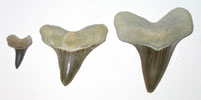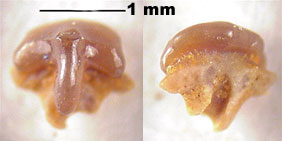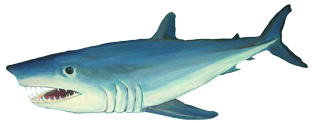
FossilsSwimming Reptiles: Mosasaurs / Plesiosaurs / Turtles Flying Reptiles: Pteranodons Bony Fish: Xiphactinus / Gillicus / Saurodon / Pentanogmius / Pachyrhizodus / Cimolichthys / Apsopelix / Enchodus / Ichthyodectes / Protosphyraena Sharks: Cretoxyrhina / Squalicorax / Ptychodus / Rhinobatos Invertebrates Crinoids: Uintacrinus Clams & Oysters: Inoceramus / Rudistes / Ostrea congesta Cephalopods: Spinaptychus & Rugaptychus / Niobrarateuthis bonneri Birds: Hesperornis / Ichthyornis Other Niobrara fossils: Coprolites / Fossil Tree Other Resources: Geology of Western Kansas / Bonner Fossil Hunters / Oceans of Kansas (off-site) Though they were plentiful and were successful marine predators, sharks did not fossilize well in the Smoky Hill Chalk. Unlike bony fish such as Xiphactinus, shark bone is cartilage and requires special conditions to be preserved as a fossil. Most sharks are described by the shape of their teeth and individual sharks’ teeth are found in abundance. There are many shark genera represented in the Kansas Cretaceous. The three main types are Cretoxyrhina, Squalicorax, and Ptychodus.
|
 |
 |
 |
Cretoxyrhina teeth |
Squalicorax teeth |
Ptychodus teeth |
Rhinobatos incertus
 |
Photo courtesy Mike Everhart |
©2015 Keystone Gallery / Photos © Barbara Shelton unless otherwise noted

 Cretoxyrhina
Cretoxyrhina Squalicorax (squay-luh-kore-ax) was a smaller genus, averaging less than ten feet long. The teeth of Squalicorax are curved and have sharp, serrated edges. More sharks’ teeth are found of this type than any other in the Smoky Hill Chalk.
Squalicorax (squay-luh-kore-ax) was a smaller genus, averaging less than ten feet long. The teeth of Squalicorax are curved and have sharp, serrated edges. More sharks’ teeth are found of this type than any other in the Smoky Hill Chalk.